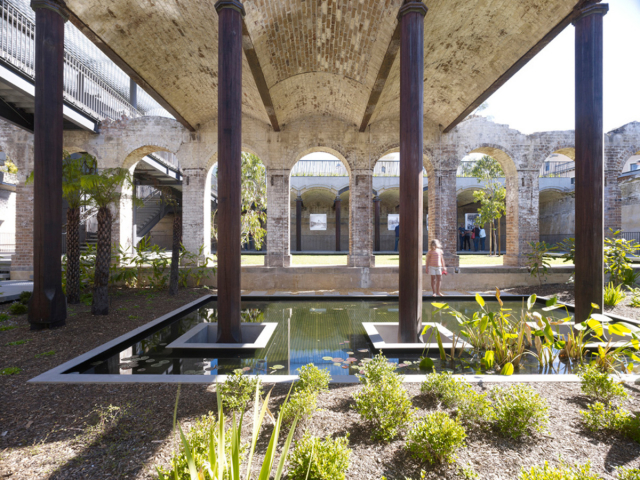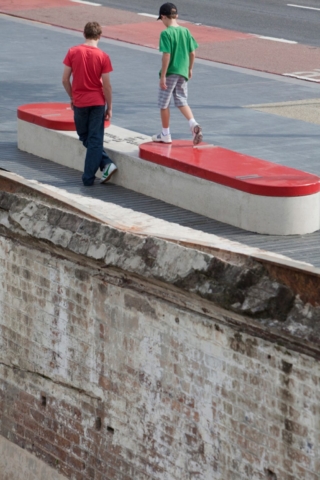When TZG and JMD were commissioned to convert the Paddington Reservoir into an urban park, the general expectation was that the site would be capped off and a brand new arrangement built on top.
However, Tonkin Zulaikha Greer and JMD design were captivated by the possibilities of revealing the 19th century structures as a ruin through which members of the public could wander, taking in the dramatic spaces and play of light across the remnants of historic walls and vaults.
Listed as a site of state heritage significance, the Paddington Reservoir was originally constructed in two stages, completed in 1866 and 1878.
The water chambers were built below street level with a grassed park above, opened to the public in the 1930’s. The operational life of the reservoir ceased in 1899 and the site was used as a workshop and garage until 1990 when roof collapses forced its closure.
Tonkin Zulaikha Greer believed the concept for the project was embodied in the existing artefact.
An accessible sunken garden and pond, surrounded by a raised pre-cast concrete boardwalk, has been inserted within the conserved ruin of the western chamber of the former reservoir.
The edges of the ruin are contained by concrete up-stands in such a way as to amplify the distinctive curved characteristics of the original brick vaults. The Victorian tree-fern garden hints at the era in which the Reservoir was originally built.
The eastern chamber has been conserved with new timber columns and a waterproof concrete structure over, stabilising the brickwork and forming the base for the new landscaped park above.
Two lightweight roofs float above the reservoir, signalling the main entry points to the park.
The lightness of the roofs act as a counterpoint to the solid earthiness of the masonry vaults, while there is a whimsical reference to the older masonry mortar joints in the staggered pattern of the metal grid.
A restricted pallet of three materials – steel, aluminium and concrete were chosen as contemporary partners for the historic brick, cast iron and timber, united as they are in their raw industrial expression.
This quality, crucial to sustaining the memory of the original purpose of the structure, is softened by the status given to the planting and also by the overt invitation, implicit in the walkways, to explore the whole park.
Project Awards
- 2010 International Architecture Award, The Chicago Athenaeum and The European Centre for Architecture, Art, Design and Urban Studies
- 2010 National Australian Institute of Architecture Award for Urban Design
- 2010 National Australian Institute of Architecture Award for Heritage Architecture
- 2010 Shortlisted Entry, World Architecture Festival Old & New Category
- 2010 Lloyd Rees Award for Urban Design, Australian Institute of Architecture (NSW) Awards
- 2010 Greenway Award for Heritage, Australian Institute of Architecture (NSW) Awards
- 2010 Australian Institute of Landscape Architects Landscape Architecture Medal, 2010
- 2010 Energy Australia/National Trust Heritage Award – Adaptive Reuse (Corporate/Government)
- 2009 Planning Institute of Australia, Australia Award for Urban Design
- 2009 Australian Property Institute, Officer of the Valuer General Heritage Award
- 2009 Landscape Architecture Medal, Australian Institute of Landscape Architects
- 2009 Design Excellence Award, Australian Institute of Landscape Architects
Project Details
Project Size – 4,200 m2
Completion Date – 2009
Project Team
Architecture
Tonkin Zulaikha Greer
Tonkin Zulaikha Greer has a special interest in public spaces, public buildings and “edge” architecture, often providing buildings with roles and uses outside their traditional functions.
The crossover between art and architecture is a springing point for a design philosophy, which takes each project as a new challenge, without reliance on established precedents.
Constant reinvention of their architecture brings a surprising diversity to their completed projects, with an on-going sense of exploration and discovery.
The work is consistently and thoughtfully grounded by appropriateness and sustainability.
Landscape Architecture
JMD design
JMD design is a landscape architectural practice committed to designing sustainable, creative and liveable outdoor environments that contribute to the social, cultural and environmental wellbeing of all.
Photography
Brett Boardman
Brett is a well-established commercial and architectural photographer based in Sydney.
Photo Gallery
Click on a thumbnail image to enlarge.
Design © 2020 Tonkin Zulaikha Greer. All Rights Reserved.| Images © 2020 Brett Boardman. All Rights Reserved.
Get the Builtworks Letter
In every edition of the Builtworks Letter, you’ll get the behind-the-scenes backstory as to how buildings are designed, built, and brought to life.
You’ll hear compelling stories, learn surprising ideas, meet engaging characters, and discover unique voices.






















